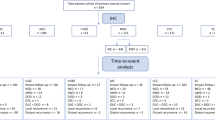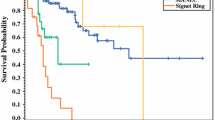Abstract
Goblet cell carcinoid (GCC) of the vermiform appendix is an uncommon neoplasm and its histogenesis is controversial. Whether GCC represents a morphological variant of classical appendiceal carcinoid or a mucin-producing adenocarcinoma is still conjectural. Little is known about the immunohistochemical expression of cytokeratins 7 (CK7) and 20 (CK20) in appendiceal neuroendocrine tumors. In this study, we compared the expression of CK7 and CK20 in 17 cases of appendiceal GCC and 25 cases of classical carcinoid. The tumors were also evaluated for Ki-67 proliferation index, mitotic activity, tumor necrosis, extracellular pools of mucin, obvious intestinal type adenocarcinomatous foci, angiolymphatic permeation, perineural/neural infiltration, and the depth of invasion of the appendix wall. Mesoappendiceal extension was present in 14 of 17 (82.3%) cases of GCC, whereas angiolymphatic and perineural/intraaneural involvement were found in 10 of 17 (58.8%) and 14 of 17 (82.3%) cases, respectively. The mitotic count ranged from 0 per 10 high power fields to 6 per 10 high power fields, with an average of 1.4 per 10 high power fields. Necrosis was not seen in any case and pools of extravasated mucin were present in 5 of 17 (29.4%) cases. Immunohistochemically, all 17 (100%) of GCC exhibited strong and diffuse immunopositivity for CK20, whereas expression of CK7 was present in 12 cases (70.5%), ranging from 5 to 50% of tumor cells being labeled. The Ki-67 labeling index ranged from 0 to 75% and showed no correlation to mitotic activity, angiolymphatic invasion or perineural/intraneural permeation. On the other hand, 25 cases of classical carcinoid tumors were consistently negative for CK7; however, 4 cases (16%) showed immunolabeling for CK20 in 25–50% of the tumor cells. The Ki-67 labeling index in classical carcinoids ranged from 0 to 5%. This study shows that in addition to the morphological differences, GCC (CK7/CK20-positive) and classical carcinoid (CK7/CK20-negative) differ in their expression of CK7 and CK20. In addition, GCC shows the same CK7/CK20 immunoexpression as colorectal adenocarcinoma. Goblet cell carcinoid should be regarded as a crypt cell or an amphicrine carcinoma rather than a variant of carcinoid tumor, a lesion that has benign connotations.
Similar content being viewed by others
References
Gagne F, Fortin P, Dufour V, Delaqe C. Tumors of the appendix associating histologic features of carcinoid and adenocarcinoma. Ann Anat Pathol 14:393–406, 1969.
Subbuswamy SG, Gibbs NM, Ross CF, Morson BC. Goblet cell carcinoid of the appendix. Cancer 34:338–44, 1974.
Butler JA, Houshiar A, Lin F, Wilson SE. Goblet cell carcinoid of the appendix. Am J Surg 168:685–7, 1994.
Gallegos NC, Milroy C, Linehan IP, Boulos PB. Crypt cell carcinoma of the appendix. Eur J Surg Oncol 18:386–7, 1992.
Goddard MJ, Lonsdale RN. The histogenesis of appendiceal carcinoid tumors. Histopathology 20:345–9, 1992.
Goede AC, Caplin ME, Winslet MC. Carcinoid tumour of the appendix. Br J Surg 90:1317–22, 2003.
Isaacson P. Crypt cell carcinoma of the appendix (so-called adenocarcinoid tumour). Am J Surg Pathol 5:213–4, 1981.
Warner TFCS, Seo IS. Goblet cell carcinoid of appendix; ultrastructural features and histogenetic aspects. Cancer 44:1700–6, 1979.
Wolff M. Crypt cell carcinoma. Am J Surg Pathol 6:188–9, 1982.
Ramnani DM, Wistuba II, Behrens C, Gazdar AF, Sobin LH, Albores-Saavedra J. K-ras and p53 mutations in the pathogenesis of classical and goblet cell carcinoids of the appendix. Cancer 86:14–21, 1999.
Stancu M, Wu TT, Wallace C, Houlihan PS, Hamilton SR, Rashid A. Genetic alterations in goblet cell carcinoids of the vermiform appendix and comparison with gastrointestinal tumors. Mod Pathol 16:1189–98, 2003.
Li CC, Hirowaka M, Qian ZR, Xu B, Sano T. Expression of E-cadherin, β-catenin, and Ki-67 in goblet cell carcinoids of the appendix: an immunohistochemical study with clinical correlation. Endocr Pathol 13:47–58, 2002.
Al-Talib RK, Mason CH, Theaker JM. Combined goblet cell carcinoid and mucinous cystadenoma of the appendix. J Clin Pathol 48:869–70, 1995.
Lin BT, Gown AM. Mixed carcinoid and adenocarcinoma of the appendix: report of 4 cases with immunohistochemical studies and a review of the literature. Appl Immunohistochem Mol Morphol 12:271–6, 2004.
Misdraji J. Neuroendocrine tumours of the appendix. Curr Diag Pathol 11:180–93, 2005.
Pahlavan PS, Kanthan R. Goblet cell carcinoid of the appendix. World J Surg Oncol 20(3)36, 2005.
Kanthan R, Saxena A, Kanthan SC. Goblet cell carcinoids of the appendix. Immunophenotype and ultrastructural study. Arch Pathol Lab Med 125:86–90, 2001.
Varisco B, McAlvin B, Dias J, Franqa D. Adenocarcinoid of the appendix: is right hemicolectomy necessary? A meta-analysis of retrospective chart reviews. Am Surg 70:593–9, 2004.
Pham TH, Wolff B, Abraham SC, Drelichman E. Surgical and chemotherapy treatment outcomes of goblet cell carcinoid: a tertiary cancer center experience. Ann Surg Oncol 13:370–6, 2006.
Stinner B, Rothmund M. Neuroendocrine tumours (carcinoids) of the appendix. Best Pract Res Clin Gastroenterol 19:729–38, 2005.
Kende AI, Carr NJ, Sobin LH. Expression of cytokeratins 7 and 20 in carcinomas of the gastrointestinal tract. Histopathology 42:137–60, 2003.
Tjalma WA, Schatteman E, Goovaerts G, Verkinderen L, Van-den Borre F, Keersmaekers G. Adenocarcinoid of the appendix presenting as a disseminated ovarian carcinoma: report of a case. Surg Today 30:78–81, 2000.
Kato T, Terashima T, Tomida S, Yamaguchi T, Kawamura H, Kimura N, et al. Cytokeratin 20-positive large cell neuroendocrine carcinoma of the colon. Pathol Int 55:524–9, 2005.
Moll R, Zimbelmann R, Goldsvhmidt MD, Keith M, Laufer J, Kasper M, et al. The human gene encoding cytokeratin 20 and its expression during fetal development and in gastrointestinal carcinomas. Differentiation 53:75–93, 1993.
Kloppel G, Perren A, Heitz PU. The gastroenteropancreatic neuroendocrine cell system and its tumors. The WHO classification. Ann N Y Acad Sci 1014:13–27, 2004.
Author information
Authors and Affiliations
Corresponding author
Rights and permissions
About this article
Cite this article
Alsaad, K.O., Serra, S., Schmitt, A. et al. Cytokeratins 7 and 20 Immunoexpression Profile in Goblet Cell and Classical Carcinoids of Appendix. Endocr Pathol 18, 16–22 (2007). https://doi.org/10.1007/s12022-007-0004-x
Published:
Issue Date:
DOI: https://doi.org/10.1007/s12022-007-0004-x




